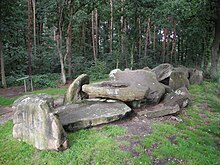Hekeser stones
| Hekeser stones | ||
|---|---|---|
|
Hekeser Steine stone row |
||
|
|
||
| Coordinates | 52 ° 35 '22.8 " N , 7 ° 46' 45.1" E | |
| place | Hekese , Lower Saxony , Germany | |
| Emergence | 3500 to 2800 BC Chr. | |
| Sprockhoff no. | 883 and 884 | |
The Hekes stones are two Neolithic megalithic systems of the funnel cup culture (TBK) in Lower Saxony . They are located south of Hekese , a district of Berge , and north of Restrup , a district of Bippen . They are the only ones in Germany connected with a row of stones . The complex is on the street of the megalithic culture .
The megalithic systems from the Neolithic Age were created by the Funnel Beaker Culture (TBK) between 3500 and 2800 BC. Built in BC. Neolithic monuments are an expression of the culture and ideology of Neolithic societies. Their origin and function are considered to be the hallmarks of social development.
Both systems of the Emsland Chamber type are slightly trapezoidal and had nine cap stones, of which the two outer and the middle one rest on three stones in the form of three-point supports, while the other groups of cap stones (two times three stones) were erected as yokes .
North Chamber B
The north of the chambers ( Sprockhoff No. 883) is relatively well preserved. Many of the 20 supporting stones that have been preserved are still in situ . One of the seven existing capstones is on top, the others have collapsed into the 19 meter long and 3.5 - 2.7 m wide trapezoidal chamber and partially broken. The entrance to the passage grave is said to have been in the middle of the southwest long side, where there is a gaping gap.
South Chamber A
About 50 m to the south and slightly offset is the second, also relatively well preserved, 20 m long and 2.6–3.0 m wide trapezoidal passage grave (Sprockhoff no. 884). Eleven bearing stones form the south-western long side and nine the north-eastern one. Some of these, as well as one of the keystones, are tilted. All nine capstones are in place, but collapsed into the chamber. The entrance is assumed to be in the middle of the southwest long side.
Row of stones
The row of stones that runs between the two chambers is unusual. Over a length of 53 meters, menhirs connect the chambers in a slightly curved, not entirely complete line. Attempts have been made to address the stone setting as the remainder of an enclosure. However, it turns out that the row starts on the central axes of the chambers and not to the side of them. Similar stone setting are otherwise only known from the megalithic of Western Europe . The only other example from Central Europe was a row of stones between the large stone graves 8 and 9 near Emmendorf in the Uelzen district, which were destroyed in the 19th century . Since there are no findings from either site, the function of the row of stones remains unknown.
See also
literature
- Anette Bußmann : Stone Age witnesses. Travel to the prehistory of northwest Germany. Isensee Verlag, Oldenburg 2009, ISBN 978-3-89995-619-1 , pp. 49-51.
- Mamoun Fansa : large stone graves between Weser and Ems . Isensee Verlag, Oldenburg 1992, pp. 80-83 ISBN 3-89442-118-5
- Johannes Groht: Menhirs in Germany. State Office for Monument Preservation and Archeology Saxony-Anhalt, Halle (Saale) 2013, ISBN 978-3-943904-18-5 , p. 229.
- Wolfgang Schlueter : The great stone graves of the Osnabrück area . In: Guide to prehistoric and early historical monuments 44. Mainz 1979, pp. 2–4.
- Ernst Sprockhoff : Atlas of the megalithic tombs Germany. Part 3: Lower Saxony - Westphalia. Rudolf Habelt Verlag, Bonn 1975, ISBN 3-7749-1326-9 , pp. 112-114.
Web links
Individual evidence
- ↑ J. Müller In: Varia neolithica VI 2009 p. 15



